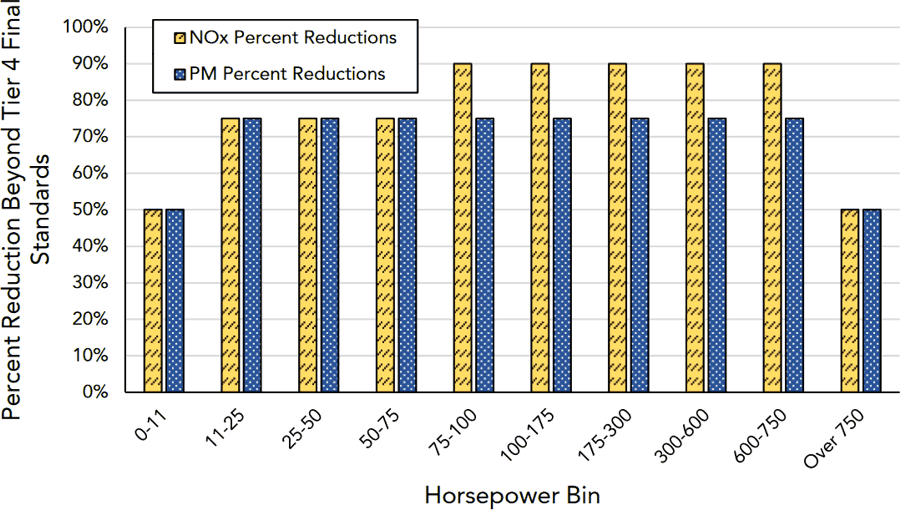CARB developing Tier 5 emission standards for off-road engines
5 November 2021
On November 3, 2021, the California Air Resources Board (CARB) held remotely the first public workshop on the development of Tier 5 emission standards that will seek to further reduce NOx and PM emissions from off-road engines by 50-90%—depending on the engine power category—in the 2028-2030 timeframe. CARB has not yet released a formal Tier 5 proposal—rather, a number of concepts have been presented with the intention to solicit feedback from engine manufacturers and other stakeholders.
Please log in to view the full version of this article (subscription required).
The considered Tier 5 regulation is structured in a similar way to the California low NOx regulation for heavy-duty onroad engines—it includes more stringent emission limits, a new low load certification test cycle, and extended emission durability periods. However, the considered Tier 5 emission limits and other regulatory changes are somewhat less stringent compared to the onroad engine program. As was the case with the onroad regulation, a low NOx off-road demonstration project is being conducted by the SwRI.
For the CARB Tier 5 emission standards to be meaningfully effective, the elephant in the room is the cooperation of the US Environmental Protection Agency (EPA). Without a corresponding nonroad engine regulation by the EPA, California-only Tier 5 standards would have a limited scope and could produce only very limited emission reductions. There are two reasons why CARB needs a US EPA Tier 5 regulation. First, federal Clean Air Act Amendments of 1990 preempt California’s authority to control emissions from new farm and construction equipment under 175 hp—a category representing some 50% of California off-road engine emissions. Second, current regulations do not prevent bringing off-road engines and equipment from other states to California. If California Tier 5 engines are more expensive than out-of-state Tier 4 engines, many California customers can be expected to purchase their off-road equipment out of state.
At the workshop, CARB staff presented several reasons why California needs to tighten the off-road engine emission regulations:
- Current Tier 4 final off-road diesel standards do not reflect best available control technologies (BACT). Importantly, current standards can be met without diesel particulate filters (DPF)—over 50% of Tier 4 final engines are certified without a DPF.
- Additional emission reductions are needed for attainment of federal and state ambient air quality standards.
- Off-road emissions disproportionately affect disadvantaged communities.
- Current test cycles may not adequately demonstrate emissions control during low load off-road engine operation.
The potential Tier 5 amendments to the off-road engine regulations are expected to be proposed around 2024-2025. The implementation schedule would start from 2028 for non-preempted engines, and from 2030 for preempted engines.
The key components that are potentially considered for the Tier 5 regulation include:
- More stringent emission limits for NOx and PM, Figure 1. For engines of 56 - 560 kW, NOx/PM emission limits would be reduced by 90%/75%, respectively. No changes are planned to the current CO and NMHC emission limits.

Figure 1. Possible NOx and PM Tier 5 emission standard reductions - A zero emission limit for engines below 19 kW (25 hp).
- A GHG emission standard for off-road engines targeting a tailpipe GHG emission reduction of 5-8.6%.
- A low load certification cycle for off-road engines. SwRI data show NOx emissions from their Low Load Application Cycle (LLAC)—considered for Tier 5 testing—are up to 19 times higher than NOx emissions from the NRTC used to certify off-road engines.
- A dedicated hybrid powertrain certification procedure.
- Increased full useful life (FUL) periods and lengthened emission warranty periods. For engines of 56-560 kW, the FUL would increase by 50%, from 8,000 to 12,000 hours.
- Idling reduction requirements.
- SCR inducements concepts such as codifying the US federal requirements (40 CFR 1039.110 and 1039.665) and introducing inducement requirements beyond SCR.
- Adopt OBD requirements for off-road engines.
- Adopt a manufacturer run in-use testing program.
- Eliminate flex/transition period engine flexibilities, as they can dilute the emission benefits for many years.
Chris Sharp of SwRI discussed the Tier 5 engine demonstration. The nominal NRTC emission targets for the program are NOx = 0.04 g/kWh and PM = 0.005 g/kWh—representing an emission reduction of 90% and 75% from the respective Tier 4 standards—to be achieved with an aftertreatment system aged to 12,000 hours. The base engine for the demonstration is John Deere 6068 (6.8 L, 187 kW @ 2200 rpm).
Incorporating current DPF technology is sufficient to meet the PM emission goal. Therefore, a DPF will be a part of the final aftertreatment system, and the ongoing technology effort will focus on meeting the NOx target.
There are two sets of objectives, or “packages”, for the demonstration:
- Low cost package—meet NOx emissions at a constant GHG emissions.
- Meet the NOx emission target while achieving a GHG emission reduction of 5-8.6%.
The hardware options considered for the demonstration include cylinder deactivation (CDA via Jacobs Vehicle Systems with Tula diesel dynamic skip fire, dDSF), heated urea mixer and/or electric heater, and EGR cooler bypass at idle. The latter option can avoid cooled EGR at idle due to OEM concerns, and is considered superior to intake throttle (throttle use is to be limited to regeneration).
Source: CARB